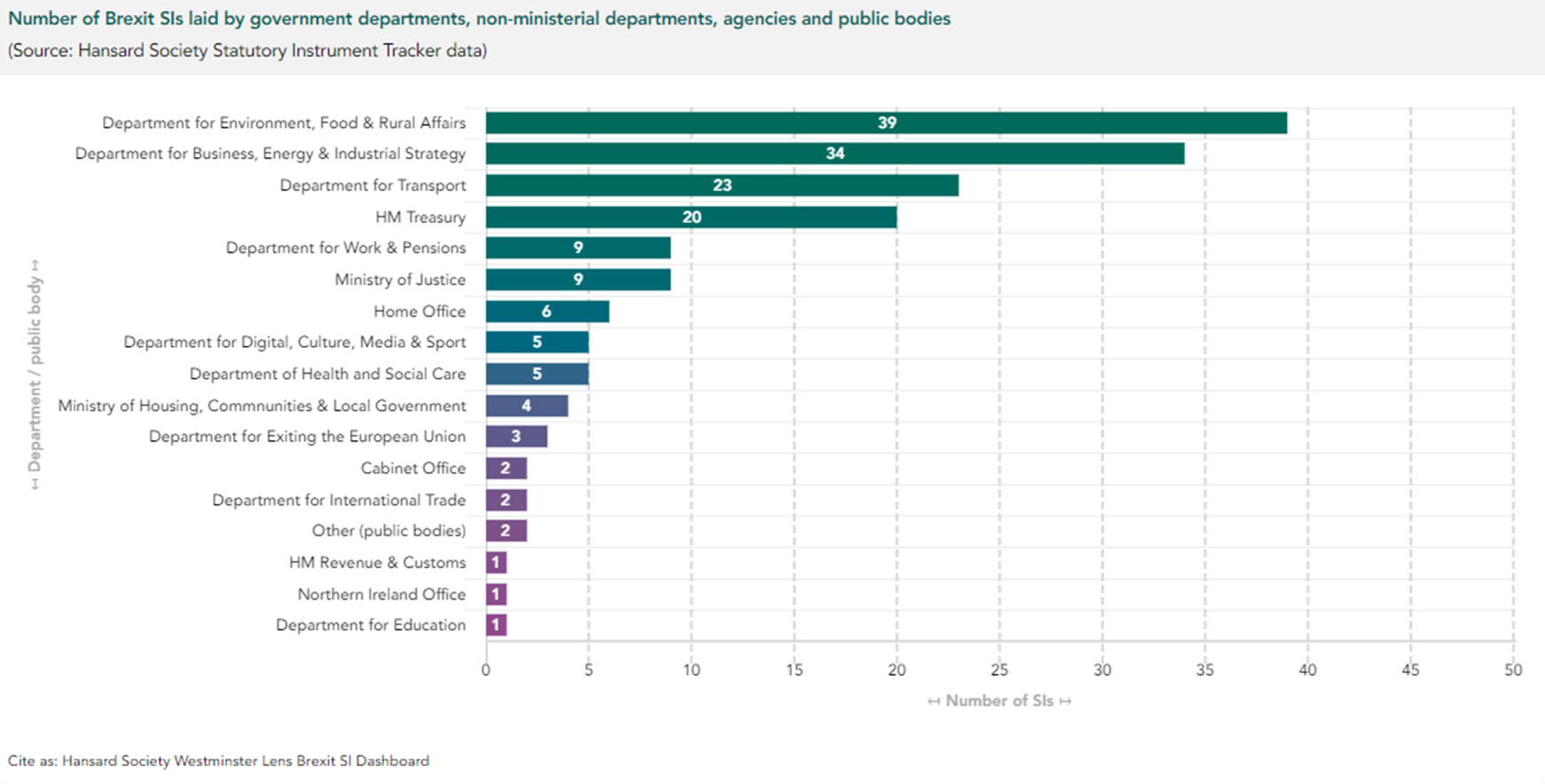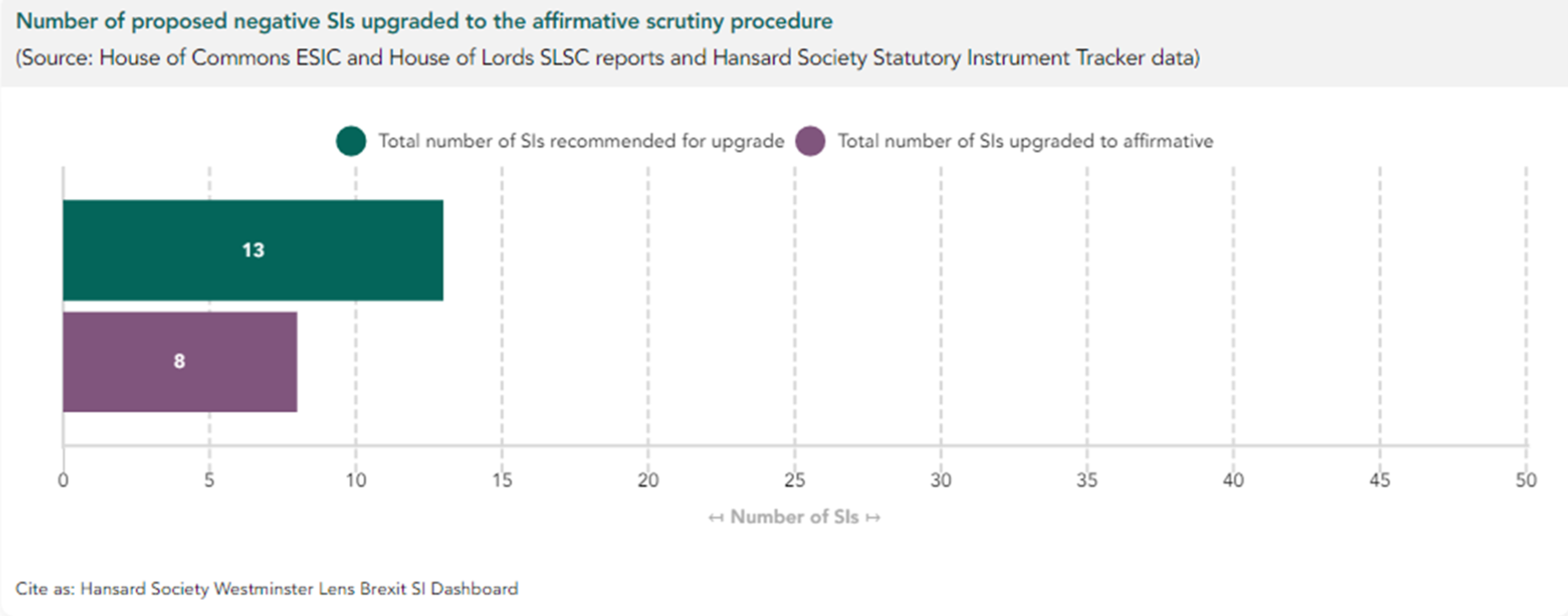 The Hansard Society has been tracking how many of the 800-1000 statutory instruments the government says it needs to deliver Brexit have been laid before Parliament. With only four months to go, only 21% have reached the Houses – leaving MPs and peers with very little time to scrutinise them, writes Joel Blackwell (Hansard Society).
The Hansard Society has been tracking how many of the 800-1000 statutory instruments the government says it needs to deliver Brexit have been laid before Parliament. With only four months to go, only 21% have reached the Houses – leaving MPs and peers with very little time to scrutinise them, writes Joel Blackwell (Hansard Society).
There are just 127 days to go until the UK’s exit from the EU on 29 March 2019, but Hansard Society data, taken from our latest Westminster Lens: Brexit Statutory Instruments Dashboard, shows that only 21% of the minimum number of Statutory Instruments (SIs) the government says are needed to deliver Brexit have been laid before Parliament. If the government does not increase the pace, Parliament will shortly be faced with the impossible task of scrutinising too many SIs in too little time.
Avoiding a ‘peak and trough’ approach

Ministers have regularly said that they expect to lay between 800 and 1,000 statutory instruments to prepare the statute book for exit day, with the final figure probably closer to 800. The government has also promised it would try and avoid a ‘peak and trough’ approach to the production of the SIs so Parliament could do its scrutiny job properly. However, since the EU (Withdrawal) Act was granted Royal Assent on 26 June, half the time available to make changes to the statute book before exit day next March has now elapsed; yet, as the chart below shows, only 166 of the 800 SIs required have so far been laid.
Following the passage of the Act, there were 40 weeks until exit day, meaning that if a minimum of 800 Brexit SIs had to be laid, the government would be required to lay an average of 20 SIs each week. So far it is laying an average of just 6 SIs per week.
In response to concerns raised by the Chair of the House of Commons Procedure Committee over this slow flow of Brexit SIs, the Department for Exiting the European Union (DEXEU) published an indicative timetable for the remaining SIs expected to be published each month up until exit day. DEXEU stated that it was, “working hard to ensure a manageable flow” of Brexit SIs, with November estimated to be the busiest month with between 150-200 Brexit SIs laid before Parliament, followed by 100-150 SIs in both December and January and then 10-50 SIs in each of February and March. We are now halfway through November, but only 62 of the expected 150-200 SIs have been laid.
Which government departments are laying most Brexit SIs?
In the same response to the Chair of the Procedure committee, DEXEU also confirmed that the majority of Brexit SIs would emanate from the Department for Environment, Food and Rural Affairs (DEFRA), HM Revenue & Customs, HM Treasury, the Department for Transport (DfT) and the Department for Business, Energy & Industrial Strategy (BEIS). As the chart above shows, Defra has thus far laid the most Brexit-related SIs (39), followed by BEIS (34) and the Department for Transport (23). A National Audit Office assessment of the DfT’s readiness for Brexit published earlier this year reported that the Department planned to produce 63 new exit-related SIs, meaning that the Department has so far laid 37% of its total number. In evidence to the House of Commons Public Accounts Committee on 15 October 2018, the DEFRA Permanent Secretary said that about 850 separate bits of legislation have been grouped into 86 Brexit SIs, with the Department therefore having laid 45% of its required total number.
SI ‘urgency’ process ahead?
The slow rate at which the government is laying the SIs before Parliament means the clock is ticking on the effectiveness of the new sifting process created under the European Union (Withdrawal) Act.
Under the process, the new House of Commons European Statutory Instruments Committee (ESIC) and the House of Lords Secondary Legislation Scrutiny Committee (SLSC) are tasked with ‘sifting’ proposed negative SIs laid using powers in the EU (Withdrawal) Act and deciding whether any of them should be upgraded to the affirmative scrutiny procedure and thus be debated by MPs and Peers. This sifting, which got underway in September, adds 10 days to the usual 40-day scrutiny period for negative SIs. If the government accepts any recommendation made by a sifting committee to upgrade a proposed negative SI there is no time-limit on the scrutiny period for affirmative SIs.
Of the 166 Brexit SIs laid so far, 107 are proposed negative SIs laid using powers in the EU (Withdrawal) Act. Of these:
• The ESIC has considered 73 of them and recommended an upgrade in the scrutiny procedure for 12 (16%) of them.
• The SLSC has considered 73 of them and recommended an upgrade in the scrutiny procedure for 9 (12%) of them.
• The two committees reached the same decision in favour of upgrading the scrutiny procedure in relation to 8 of the SIs.
In total, 13 proposed negative SIs have been recommended for upgrade to the affirmative procedure by the sifting committees and the government has accepted eight of those recommendations.
However, by early February sifting may have to be bypassed completely as there will be too little time before exit day to subject proposed negative SIs to the procedure. At this point the government may have to trigger the ‘urgent case’ procedure provided for in the EU (Withdrawal) Act to get its legislation through Parliament. The urgency procedure allows ministers to lay ‘made affirmative’ SIs that come into effect immediately, but can only stay in effect if subsequently approved by both Houses of Parliament within 28 days. Ministers can also lay ‘made negative’ SIs under the urgency procedure and these are exempt from the parliamentary sifting process. The only constraint on the exercise of this power is that the government must table a written statement explaining the need for urgency.
If Parliament is to have the time necessary to properly scrutinise Brexit SIs, the government’s production needs to accelerate rapidly.
In the run-up to the UK’s exit from the EU on 29 March 2019 we will continue to track the progress made by government and Parliament in preparing the statute book for exit day. Our analysis draws on parliamentary data and our own Statutory Instrument Tracker which we built several years ago to support our research on delegated legislation.
This post represents the views of the author and not those of the Brexit blog, nor the LSE.
Joel Blackwell is senior researcher at the Hansard Society.










1 Comments